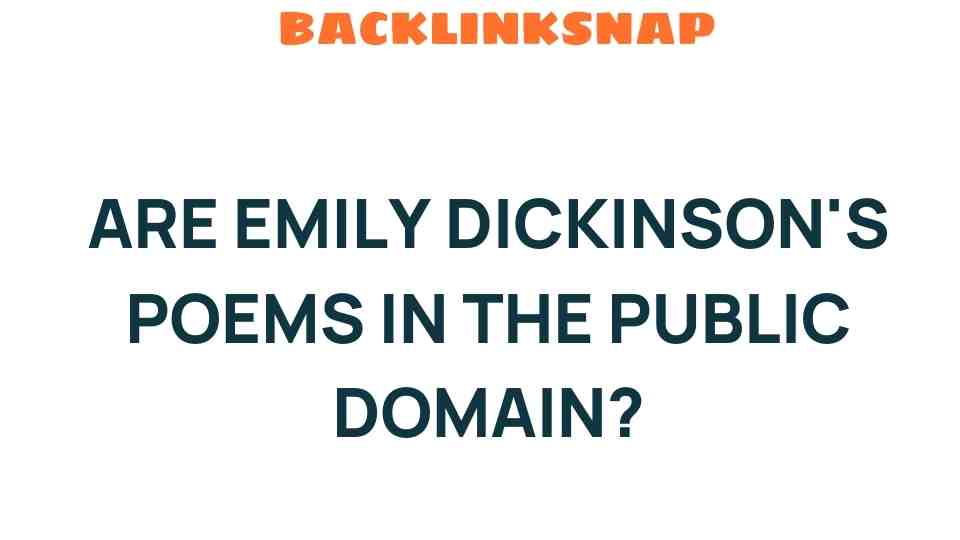Are Emily Dickinson’s Poems in the Public Domain?
Emily Dickinson, a luminary in the realm of 19th-century literature, has captivated readers with her profound insights and unique poetic style. As her works continue to resonate, a pertinent question arises: Are Emily Dickinson’s poems in the public domain? This inquiry not only touches on copyright law and intellectual property but also highlights the importance of access to literature and the preservation of our literary heritage.
The Basics of Copyright Law
To understand whether Dickinson’s poetry resides in the public domain, we must first delve into copyright law. Copyright grants creators exclusive rights to their works for a specified duration, typically allowing them to control reproduction, distribution, and adaptation. In the United States, copyright law has evolved significantly over the years, with key legislation influencing the duration of protection.
Originally, copyright lasted for 14 years, with the option to renew for another 14. The Copyright Act of 1976 extended this duration to the author’s life plus 50 years. However, the Sonny Bono Copyright Term Extension Act of 1998 further extended this period to the life of the author plus 70 years, which marks a crucial point in our discussion.
Emily Dickinson’s Life and Literary Legacy
Emily Dickinson was born on December 10, 1830, and passed away on May 15, 1886. As a prolific poet, she penned nearly 1,800 poems, many of which were not published until after her death. Given her passing in 1886, one might wonder how copyright law applies to her works today.
Since Dickinson died over 70 years ago, her poems entered the public domain on January 1, 1957. This means that anyone can access, reproduce, and adapt her works without seeking permission or paying royalties. As a result, Dickinson’s poetry is freely available for scholars, artists, and enthusiasts, enriching our cultural landscape and fostering a deeper understanding of her literary genius.
The Importance of Public Domain Works
The public domain plays a vital role in preserving and disseminating our literary heritage. Works that fall under this umbrella are accessible to everyone, encouraging creativity and exploration. By having access to Emily Dickinson’s poems, readers can:
- Engage with her unique voice and perspective.
- Incorporate her themes into new creative works.
- Study her influence on contemporary poetry and literature.
- Share her insights with future generations.
Public domain works like Dickinson’s empower individuals and institutions alike, fostering an environment ripe for innovation and collaboration.
Access to Literature in the Digital Age
In today’s digital landscape, the public domain has become even more crucial. With the rise of online platforms, readers can easily access a wealth of literary works, including Dickinson’s poems. Websites such as Poetry Foundation and Project Gutenberg offer free access to her writings, ensuring her voice remains vibrant and relevant.
The availability of Dickinson’s poetry allows educators to incorporate her work into classrooms, scholars to conduct research, and poets to draw inspiration. This fosters a spirit of community and shared knowledge, reinforcing the notion that literature belongs to everyone.
Challenges in the Digital Era
While the public domain facilitates access, challenges still exist, particularly concerning the digital reproduction of literary works. With the proliferation of online content, issues related to copyright infringement and unauthorized adaptations can arise. It’s essential for readers and creators to understand their rights and the boundaries of intellectual property when engaging with public domain works.
Moreover, while Dickinson’s original texts are in the public domain, certain published editions, annotations, or collections may still be protected under copyright. Thus, readers should verify the status of specific versions before using them in their own creative or scholarly endeavors.
Conclusion
In summary, Emily Dickinson’s poems are indeed in the public domain, allowing unfettered access to her profound insights and unique literary style. This legacy not only enriches our cultural heritage but also serves as a testament to the enduring power of literature. As we navigate the complexities of copyright law and intellectual property, it is vital to recognize the importance of public domain works in fostering creativity and collaboration.
As we move forward, let us cherish and uphold the literary treasures of the past, ensuring that voices like Emily Dickinson’s continue to inspire and resonate for generations to come.
Frequently Asked Questions (FAQs)
1. What does it mean for a work to be in the public domain?
A work in the public domain is free from copyright restrictions, allowing anyone to use, reproduce, and adapt it without seeking permission or paying royalties.
2. When did Emily Dickinson’s poems enter the public domain?
Emily Dickinson’s poems entered the public domain on January 1, 1957, 70 years after her death in 1886.
3. Can I use Emily Dickinson’s poems in my own creative work?
Yes! Since her poems are in the public domain, you can freely use them in your own creative works without needing permission.
4. Are there any restrictions on using public domain works?
While public domain works are free to use, specific editions or adaptations may still be under copyright, so it’s important to verify the status of the particular work you wish to use.
5. How can I access Emily Dickinson’s poems online?
Many websites, such as Poetry Foundation and Project Gutenberg, offer free access to her poems.
6. Why is the public domain important for literature?
The public domain ensures that literary works are accessible to all, promoting creativity, education, and the preservation of cultural heritage.
This article is in the category Digital Marketing and created by BacklinkSnap Team




